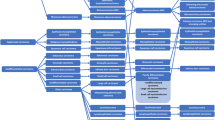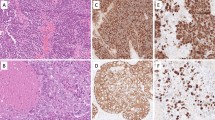Abstract
To investigate if viruses are involved in the pathogenesis of vestibular schwannomas (VS), we have screened biopsies from VS patients using different molecular techniques. Screening for the presence of known viruses using a pan-viral microarray assay (ViroChip) indicated the presence of several viruses including human endogenous retrovirus K (HERV-K) and human herpes virus 2 (HHV2). But with the exception of HERV-K, none of the findings could be verified by other methods. Whole transcriptome sequencing showed only the presence of HERV-K transcripts and whole genome sequencing showed only the presence of Epstein-Barr virus, most likely originating from infiltration of lymphocytes. We therefore conclude that it is less likely that viruses are involved in the pathogenesis of vestibular schwannomas.
Similar content being viewed by others
References
Baloh RW (2003) Clinical practice. Vestibular neuritis. N Engl J Med 348:1027–1032
Bhimrao SK, Maguire J, Garnis C, Tang P, Lea J, Akagami R, Westerberg BD (2015) Lack of association between human herpesvirus and vestibular schwannoma: analysis of 121 cases. Otolaryngol Head Neck Surg 152:513–517
Birdwell CE, Queen KJ, Kilgore PC, Rollyson P, Trutschl M, Cvek U, Scott RS (2014) Genome-wide DNA methylation as an epigenetic consequence of Epstein-Barr virus infection of immortalized keratinocytes. J Virol 88:11442–11458
Chang Y, Cesarman E, Pessin MS, Lee F, Culpepper J, Knowles DM, Moore PS (1994) Identification of herpesvirus-like DNA sequences in AIDS-associated Kaposi's sarcoma. Science 266:1865–1869
Chiu CY, Rouskin S, Koshy A, Urisman A, Fischer K, Yagi S, Schnurr D, Eckburg PB, Tompkins LS, Blackburn BG, Merker JD, Patterson BK, Ganem D, DeRisi JL (2006) Microarray detection of human parainfluenzavirus 4 infection associated with respiratory failure in an immunocompetent adult. Clin Infect Dis 43:e71–e76
Deboever C, Reid EG, Smith EN, Wang X, Dumaop W, Harismendy O, Carson D, Richman D, Masliah E, Frazer KA (2013) Whole transcriptome sequencing enables discovery and analysis of viruses in archived primary central nervous system lymphomas. PLoS One 8:e73956
Del Valle L, White MK, Khalili K (2008) Potential mechanisms of the human polyomavirus JC in neural oncogenesis. J Neuropathol Exp Neurol 67:729–740
Depil S, Roche C, Dussart P, Prin L (2002) Expression of a human endogenous retrovirus, HERV-K, in the blood cells of leukemia patients. Leukemia 16:254–259
Dziurzynski K, Chang SM, Heimberger AB, Kalejta RF, McGregor Dallas SR, Smit M, Soroceanu L, Cobbs CS, Hcmv GS (2012) Consensus on the role of human cytomegalovirus in glioblastoma. Neuro-Oncology 14:246–255
Feschotte C, Gilbert C (2012) Endogenous viruses: insights into viral evolution and impact on host biology. Nat Rev Genet 13:283–296
Fisher JL, Pettersson D, Palmisano S, Schwartzbaum JA, Edwards CG, Mathiesen T, Prochazka M, Bergenheim T, Florentzson R, Harder H, Nyberg G, Siesjo P, Feychting M (2014) Loud noise exposure and acoustic neuroma. Am J Epidemiol 180:58–67
Galloway DA, McDougall JK (1983) The oncogenic potential of herpes simplex viruses: evidence for a ‘hit-and-run’ mechanism. Nature 302:21–24
Golan M, Hizi A, Resau JH, Yaal-Hahoshen N, Reichman H, Keydar I, Tsarfaty I (2008) Human endogenous retrovirus (HERV-K) reverse transcriptase as a breast cancer prognostic marker. Neoplasia 10:521–533
Irving RM, Moffat DA, Hardy DG, Barton DE, Xuereb JH, Maher ER (1994) Somatic NF2 gene mutations in familial and non-familial vestibular schwannoma. Hum Mol Genet 3:347–350
Kassiotis G (2014) Endogenous retroviruses and the development of cancer. J Immunol 192:1343–1349
Langmead B, Salzberg SL (2012) Fast gapped-read alignment with Bowtie 2. Nat Methods 9:357–359
Li H, Handsaker B, Wysoker A, Fennell T, Ruan J, Homer N, Marth G, Abecasis G, Durbin R, Genome Project Data Processing S (2009) The sequence alignment/map format and SAMtools. Bioinformatics 25:2078–2079
Livak KJ, Schmittgen TD (2001) Analysis of relative gene expression data using real-time quantitative PCR and the 2(-Delta Delta C(T)) method. Methods 25:402–408
Moore PS, Chang Y (2010) Why do viruses cause cancer? Highlights of the first century of human tumour virology. Nat Rev Cancer 10:878–889
Myrseth E, Pedersen PH, Moller P, Lund-Johansen M (2007). Treatment of vestibular schwannomas. Why, when and how? Acta Neurochir 149: 647–660; discussion 660
Nevels M, Tauber B, Spruss T, Wolf H, Dobner T (2001) “Hit-and-run” transformation by adenovirus oncogenes. J Virol 75:3089–3094
Niller HH, Wolf H, Minarovits J (2011) Viral hit and run-oncogenesis: genetic and epigenetic scenarios. Cancer Lett 305:200–217
Parkin DM (2006) The global health burden of infection-associated cancers in the year 2002. Int J Cancer 118:3030–3044
Poltermann S, Schlehofer B, Steindorf K, Schnitzler P, Geletneky K, Schlehofer JR (2006) Lack of association of herpesviruses with brain tumors. J Neuro-Oncol 12:90–99
Preston DL, Ron E, Yonehara S, Kobuke T, Fujii H, Kishikawa M, Tokunaga M, Tokuoka S, Mabuchi K (2002) Tumors of the nervous system and pituitary gland associated with atomic bomb radiation exposure. J Natl Cancer Inst 94:1555–1563
Prochazka M, Feychting M, Ahlbom A, Edwards CG, Nise G, Plato N, Schwartzbaum JA, Forssen UM (2010) Occupational exposures and risk of acoustic neuroma. Occup Environ Med 67:766–771
Robinson JT, Thorvaldsdottir H, Winckler W, Guttman M, Lander ES, Getz G, Mesirov JP (2011) Integrative genomics viewer. Nat Biotechnol 29:24–26
Ron E, Modan B, Boice JD Jr, Alfandary E, Stovall M, Chetrit A, Katz L (1988) Tumors of the brain and nervous system after radiotherapy in childhood. N Engl J Med 319:1033–1039
Schneider AB, Ron E, Lubin J, Stovall M, Shore-Freedman E, Tolentino J, Collins BJ (2008) Acoustic neuromas following childhood radiation treatment for benign conditions of the head and neck. Neuro-Oncology 10:73–78
Schuz J, Steding-Jessen M, Hansen S, Stangerup SE, Caye-Thomasen P, Poulsen AH, Olsen JH, Johansen C (2011) Long-term mobile phone use and the risk of vestibular schwannoma: a Danish nationwide cohort study. Am J Epidemiol 174:416–422
Skinner GR (1976) Transformation of primary hamster embryo fibroblasts by type 2 simplex virus: evidence for a "hit and run" mechanism. Br J Exp Pathol 57:361–376
Tang KW, Alaei-Mahabadi B, Samuelsson T, Lindh M, Larsson E (2013) The landscape of viral expression and host gene fusion and adaptation in human cancer. Nat Commun 4:2513
Tsai WL, Chung RT (2010) Viral hepatocarcinogenesis. Oncogene 29:2309–2324
Urisman A, Fischer KF, Chiu CY, Kistler AL, Beck S, Wang D, DeRisi JL (2005) E-Predict: a computational strategy for species identification based on observed DNA microarray hybridization patterns. Genome Biol 6:R78
Wang D, Coscoy L, Zylberberg M, Avila PC, Boushey HA, Ganem D, DeRisi JL (2002) Microarray-based detection and genotyping of viral pathogens. Proc Natl Acad Sci U S A 99:15687–15692
Yoshida M, Miyoshi I, Hinuma Y (1982) Isolation and characterization of retrovirus from cell lines of human adult T-cell leukemia and its implication in the disease. Proc Natl Acad Sci U S A 79:2031–2035
Young LS, Rickinson AB (2004) Epstein-Barr virus: 40 years on. Nat Rev Cancer 4:757–768
zur Hausen H (2009) Papillomaviruses in the causation of human cancers - a brief historical account. Virology 384:260–265
Acknowledgments
We thank Ms. Guri Matre at Center for Medical Genetics and Molecular Medicine for technical assistance and Ms. Monica Katrine Finnkirk at the National Center for Vestibular Schwannoma and the Department of Neurosurgery for administrative work.
Author information
Authors and Affiliations
Corresponding author
Ethics declarations
Written informed consent was received from all patients before tissue harvesting and the study was approved by the Regional Ethical committee for medical research in Western Norway (2013/374).
Conflict of interest
The authors declare that they have no conflict of interest.
Additional information
Mads Aarhus and Morten Lund-Johansen were treating physicians.
Electronic supplementary material
Fig. S1
HERV-K RNA present in sVS. Amplification plot from Q-RT PCR with HERV-K primers and probe demonstrating the presence of expressed HERV-K genes in 46 sVSs and four tibial nerves. (JPG 162 kb)
Fig. S2
No evidence for the presence of HHV2 in sVS using RT-PCR. RT-PCR with HHV2 specific primers was performed on 46 sVSs, four normal controls and purified DNA from HHV2 plasmids as positive control. The electrophoresis gels demonstrate no banding in neither the sVSs nor the normal controls while the positive control demonstrate a fragment at between 100 and 200 basepairs compatible with the 142 base pair UL 30 gene fragment from HHV2. (PDF 1126 kb)
Fig. S3
No evidence for the presence of HHV2 in sVS using Q-RT-PCR. Amplification plot from Q-RT PCR with HHV1&2 specific primers and probe covering a 167 bp fragment of the UL30 gene demonstrates the absence of HHV1&2 in the sVSs. The rising plots demonstrate the positive control template in the following dilutions: 2 x 105, 2 x 104, 2 x 103, 2 x 102, 20 and 2 copy numbers per μl. (PDF 175 kb)
Fig. S4
HERV-K113 transcripts present in the sVSs analyzed with RNAseq. Alignment of transcripts from 5 sVSs subjected to RNAseq to the HERV-K113 genome. This demonstrates the presence of transcribed viral elements in the biopsies. The alignment is visualized utilizing Integrative Genomic Viewer using the NCBI reference sequence NC_022518.1. (PDF 98 kb)
Fig. S5
Epstein-Barr virus DNA present in sVS. Alignment of reads to the Epstein-Barr virus genome from the 2 sVSs subjected to whole genome sequencing. There are few reads that are spread across the genome from both samples with mean coverage of 0,13 and 0,14. The alignment is visualized utilizing Integrative Genomic Viewer using the NCBI reference sequence NC_007605.1. (PDF 65 kb)
Fig. S6
HERV-K113 DNA present in sVS. Alignment of reads to the Human Endogenous Retrovirus K113 genome from the 2 sVSs subjected to whole genome sequencing. There is good coverage across the viral genome indicating several copies in the sVS genome with mean coverage of 317 and 335. The alignment is visualized utilizing Integrative Genomic Viewer using the NCBI reference sequence NC_022518.1. (PDF 187 kb)
Table S1
HERV-K RNA present in both sVS and normal controls. The 2−ΔΔCt method was used to quantify the expression of HERV-K RNA present in sVS and normal controls. The nn3 normal control was used as a calibrator and beta actin was used as a housekeeping gene to normalize results. Two sVSs demonstrated elevated expression of HERV-K gene while the rest of the samples expressed the gene at a similar or lower level than nn3. (XLSX 27 kb)
File S1
Alignment strategy for next generation sequencing reads. The strategy for aligning the sVS transcriptomes and genomes to viral genomes are described including which version of the software that was used as well as the command lines used. (PDF 33 kb)
Rights and permissions
About this article
Cite this article
Håvik, A.L., Bruland, O., Aarhus, M. et al. Screening for viral nucleic acids in vestibular schwannoma. J. Neurovirol. 24, 730–737 (2018). https://doi.org/10.1007/s13365-018-0669-6
Received:
Revised:
Accepted:
Published:
Issue Date:
DOI: https://doi.org/10.1007/s13365-018-0669-6




